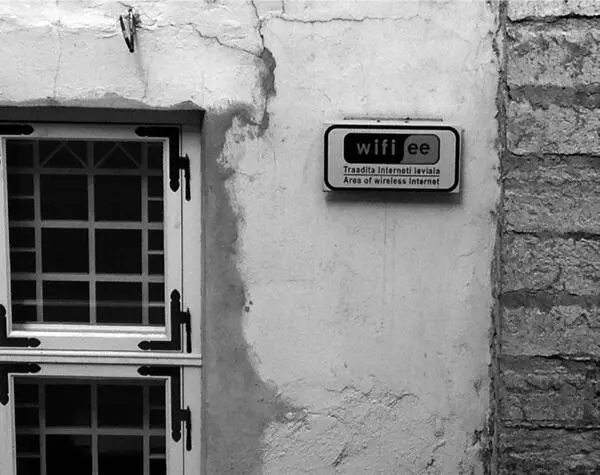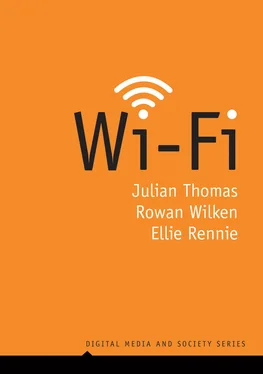
Figure 1.2 Internet everywhere: public Wi-Fi, Talinn, Estonia. Source : authors’ own.
Wi-Fi’s fundamental capability is that it enables shared, flexible, and relatively low-cost access to the internet, a valuable resource. This gives rise to a set of distinctive attributes, and these are at the heart of both the extraordinary successes of Wi-Fi and its failures. As we describe, Wi-Fi is an unusual form of network infrastructure, which augments and sometimes substitutes for other networks, while proving resistant to the power of both internet platforms and large service providers. In households, communities, and cities, Wi-Fi can work as a gap filler and a network extender. It does not rely on cutting-edge technologies or high-end processors, and Wi-Fi chips are produced in huge numbers, so the hardware is cheap. Its transmissions use the shared, publicly available spectrum, so users do not bear the costs of exclusive commercial spectrum licences. It is usually deployed on the edges of communication networks, within households and public spaces, by both end users and internet access companies. In telecommunications-speak, Wi-Fi is a ‘last mile’ technology, which can be provided, managed, and adapted by internet users themselves, whether these are families, institutions, or local communities. By the same token, the deployment of Wi-Fi doesn’t directly change underlying network infrastructures, such as the distribution or ownership of high-speed cables and switches. Nor does it change market structures, policies, or pricing models which substantially determine where and how people can connect. This means that Wi-Fi on its own is unlikely to bridge the digital divide or equalize the social distribution of digital resources. Despite the hopes of some its early advocates, Wi-Fi has not displaced commercial mobile networks. Nor has it created an open, internet commons.
For most users, Wi-Fi remains a cheap consumer ‘add-on’, with base stations often built into inexpensive internet access points provided by internet service providers. The low-cost model, a key reason for Wi-Fi’s success, probably also explains relative underinvestment in Wi-Fi compared to other wireless technologies. Newer modes of wireless connection, including the higher-speed cellular broadband services marketed as 5G, now promise higher speeds and greater security, alongside more lucrative returns for telecommunications firms, and a new upgrade cycle for smartphone manufacturers.
So why a book about Wi-Fi at this time? The experiences of 2020 underline some of the reasons why Wi-Fi matters, and is likely to matter more in the future, and why we need to understand it better than we do. When we think about how Wi-Fi has been used in the two emergencies, the bushfires and the pandemic, we can readily compare the responsive problem-solving demonstrated in the aftermath of the Australian fires with the adaptability of connected people and organizations during the pandemic. In both cases, Wi-Fi appears as a means for restoring capabilities which had been swept away, a means for managing exceptionally difficult circumstances. For those sheltering from the fires in remote townships, Wi-Fi was deployed in new ways to provide emergency support and relief for everyone with a device to connect. Reconnection was critically important for both stranded urban holiday-makers and the residents of small coastal towns, regardless of the considerable social and economic differences between these populations. Wi-Fi services in the wake of the bushfires were usually offered by telecommunications companies, which used Wi-Fi to stand in for damaged infrastructure. For those sheltering from the pandemic at home, Wi-Fi was also an essential digital resource – a means for continuity in work, education, entertainment, and social links. In the case of the pandemic, Wi-Fi was usually self-provided, in order to extend networks within households. In these circumstances, we have also seen sharply differentiated social consequences, a magnification of digital inequalities. For those without vital digital connections at home, the risk of exposure to the virus also increased, just as the absence of connectivity increased the risk of the fires.
This book shows how, in ways and circumstances other than catastrophes, Wi-Fi continues to provide vital connections. At the same time, Wi-Fi changes the way people connect with each other, media, and digital services. Internet scholars have written about how the internet ‘reconfigures access’ to resources (Dutton, 2005). Online news services, for example, may reinforce people’s interest in the news, by making news content more readily accessible; they can also change the kind of news people encounter, by presenting alternative sources of news. Wi-Fi invites us to consider how a flexible and affordable wireless medium may reconfigure access to the internet itself, both by making the internet more accessible across diverse physical and social locations, and by changing the ways in which people use it. The fact that Wi-Fi augments and extends networks from their edges should not lead us to underestimate its significance: it is possible to change the internet from its edges. Just as Wi-Fi is now enabling the proliferation of connected devices in households, a decade ago Wi-Fi played a key role in the evolution of smartphone ecosystems, providing a low-cost parallel network ideal for backups, downloads, system maintenance, synching, and all those data-intensive tasks best kept off more expensive cellular networks.
The events of 2020 give us some clues as to how this ‘reconfiguring’ works. Wi-Fi introduces a plasticity to network connections both within specific spaces and situations, such as households or cafés, and in wider public, institutional, and community settings. It does this in an unusual set of ways. We can think of Wi-Fi as ‘entangled infrastructure’, because its applications and utility are so dependent on their social and locational contexts. Wi-Fi is inexpensive to build into devices, and it provides access to the cheapest data available – usually from fixed broadband connections rather than cellular data. These qualities help us to deal with a whole range of urgent and contemporary problems, from the demands of home-based schoolwork to the communication needs of people in both extraordinary and everyday difficulties.
Wi-Fi therefore reminds us that the internet need not only be about corporate software, national rivalries, and vastly powerful platforms. It can also be successfully designed for cheap devices and open standards. However, the plasticity of Wi-Fi is not unlimited. Larger-scale network infrastructures, market dynamics, and public policy settings all play substantial parts in determining where and how people can connect. Despite the flexibility and popularity of Wi-Fi, internet access remains a scarce and expensive resource in many situations and places. While climate and health disasters underline the contingencies and fragilities of the communication systems many of us take for granted, everyday access to inexpensive, reliable internet is a daunting problem for large numbers of people, especially – but not only – in low- and middle-income countries. Mobile broadband has extended access to digital services and participation in the digital economy, but data costs remain high. According to the Alliance for Affordable Internet (2019), although progress is being made in some countries, the world is still decades away from universal, affordable internet access. Moreover, the network effects of the internet mean that, as more people are connected, the costs of disconnection – those disadvantages incurred by people who are wholly or partially excluded – also increase.
Читать дальше











